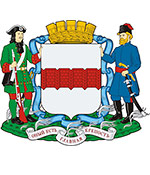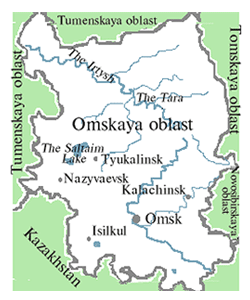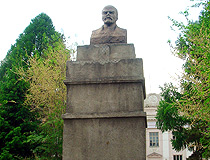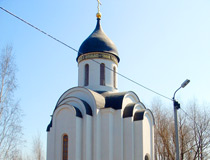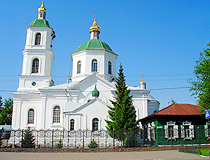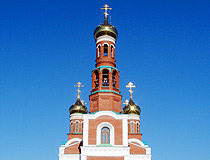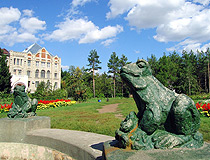History of Omsk
Foundation of Omsk
The need to build a Russian fortress on the banks of the Irtysh at the mouth of the Om River arose in connection with the steppe nomadic peoples. In particular, with the Oirats, whose tribes in the first decades of the 17th century began to appear within the borders of the Russian state being under the onslaught of their external enemies and as a result of internal civil strife. However, various foreign and domestic political problems of Russia hindered the development and defense of the South Siberian borders.
The situation changed only at the beginning of the 18th century, when the Russian conquest of Siberia intensified. Since Peter I paid great attention to geographical research in the south, the expeditions of that time combined socio-political tasks and tasks of scientific research.
One of such expeditions was led by the Russian military and statesman, associate of Peter I, Major General Ivan Bukhgolts. The goals of the expedition, numbering about 3,000 people, were to search for ore and gold deposits, the discovery of trade routes to India and China, as well as the construction of towns on the Irtysh River.
The expedition left Tobolsk to the south along the Irtysh in July 1715. In the spring of 1716, after a conflict with the Dzungars in the north of today’s Kazakhstan, the remnants of the expedition (about 700 people) withdrew to the mouth of the Om River, where they laid a new fortress named Omsky ostrog (fortified settlement).
According to the census of 1725, 992 people lived in the fortress, in 1742 - 1,092 people. From the first years of its existence, it served as a place of exile for prisoners. After serving hard labor and imprisonment, a lot of them stayed in Omsk for permanent residence.
More Historical Facts…
Omsk in the second half of the 18th century
The ethnic composition of the region’s population was formed in the process of settling the territory. Russians, Germans, Ukrainians, Poles, Belarusians, and representatives of many other nationalities were sent here to serve or were exiled. The indigenous people of the region were the Siberian Tatars and Kazakhs, who switched to a sedentary lifestyle.
The foundation of the second Omsk fortress took place in 1762. The first fortress, although it occupied a favorable geographical position, was wooden and, by the middle of the 18th century, it was dilapidated. In 1765, new stone fortifications were constructed. The first stone structure of the fortress was the Resurrection Military Cathedral, built in 1773 and preserved to this day.
In the end of the 18th century, the Omsk fortress was one of the largest structures in the eastern part of the Russian Empire, its area was more than 30 hectares. In 1782, it was transformed into a town named Omsk within the Tobolsk Governorate. In 1785, the coat of arms of Omsk was approved.
Omsk became the center of management of the Siberian transport routes and the Siberian Cossack army, which not only guarded the South Siberian borders, but also made a huge contribution to the economic development of the steppe expanses of Kazakhstan, the annexation of Central Asia to the Russian Empire.
Omsk in the 19th century
The fire of 1819 destroyed almost half of the town including the archive and the magistrate of Omsk with all the first archival documents. Therefore information about the life of Omsk in the 18th - early 19th centuries is scarce and fragmentary. In 1825, the population of the town was about 9,000 people.
In 1829, the town’s development plan was approved. It was made by the famous Petersburg architect V.I. Geste, who took the city of St. Petersburg as a model with its wide avenues, huge neighborhoods, fountains, cast-iron bridges, and an abundance of green spaces.
The composition of the population of Omsk was not quite usual. In the middle of the 19th century, since Omsk was the center of the military and civil administration, the proportion of the military in the local population reached about 60%.
Fyodor Dostoevsky (one of the greatest psychological novelists in world literature), who served a term of hard labor in the Omsk prison in 1850-1854, in a letter to his brother gave Omsk the following description: “Omsk is a disgusting town. There are almost no trees. In summer, heat and wind with sand, in winter, a snowstorm. I have not seen nature. The town is dirty, military and highly depraved.”
By the second half of the 19th century, Omsk in its development outstripped many steppe towns and became not only an administrative, but also a commercial and industrial center. In 1861, in Omsk, there were 2,122 houses (31 stone houses), 34 factories and plants, about 20 thousand residents.
In 1892, the construction of the Trans-Siberian Railway began, which gave a new impetus to the economy of Siberian towns and positively influenced Omsk. The development of the Trans-Siberian Railway caused an increase in the urban population due to migrants who came to work from the central part of the Russian Empire. According to the 1897 census, 37.3 thousand people lived in Omsk. The town had 14 streets with a total length of more than 140 km and 13 squares.
Omsk in the first half of the 20th century
The beginning of the 20th century was a time of great changes for Siberia. Mass peasant colonization caused a sharp leap in the development of the region’s economy, primarily its agrarian sector, and the Trans-Siberian Railway ensured the inclusion of the local economy in the system of the All-Russian and European markets.
Due to its favorable economic and geographical position - at the intersection of the railway and the Irtysh River, in the middle of a vast agricultural territory - Omsk quickly turned into a large transport, trade and industrial center of Western Siberia and Governor-Generalship of the Steppes (Eastern and Central Kazakhstan).
Wholesale trade in bread, butter and other agricultural products was concentrated here. Omsk also became one of the industrial, social and cultural centers of Western Siberia. By 1903, the city’s population grew to 60 thousand people. In 1914, it had about 134.8 thousand residents. Omsk became the most populous city in Siberia.
During the Civil War on the territory of the former Russian Empire, from June 1918 to November 1919, Omsk was the residence of the Supreme Ruler of Russia, Admiral Alexander Kolchak, who declared this city the capital of white Russia opposing red Russia of the Bolsheviks. Soviet power was finally established in the city in 1920.
In the summer of 1921, an event took place that had a decisive impact on the cultural and economic life of Omsk. The functions of the administrative center of Siberia were transferred from it to the city of Novonikolaevsk (future Novosibirsk). In 1934, Omsk became the administrative center of a separate Omsk Oblast.
Over the years of industrialization, Omsk became one of the largest centers for agricultural engineering in the USSR. The metal-working industry also developed at a rapid pace. In 1939, Omsk numbered more than 288 thousand people.
During the Second World War, about 200 industrial enterprises were evacuated to Omsk, as well as 60 hospitals, dozens of educational institutions, theaters, museums, and hundreds of thousands of refugees.
Omsk after the Second World War
In the post-war years, new enterprises were put into operation in Omsk, all existing factories and plants were reconstructed and expanded. The industrial potential of the city was also strengthened by the Omsk oil refinery, the largest in the country. In connection with the rapid development of industry, especially petrochemical enterprises, the ecological situation deteriorated. The concentration of harmful substances in the air sharply increased. In 1964, the population of Omsk was about 702 thousand people.
In the 1970s-1980s, Omsk developed rapidly. In 1975, the city’s population exceeded 1 million. The most pressing problem was the ecological situation. Omsk was in the top 10 cities of Russia in terms of environmental pollution. Another problem that required an immediate solution was the development of passenger transport. The capacity of Omsk streets was exhausted, and therefore the construction of the subway became an urgent issue.
The economic crisis that gripped Russia after the collapse of the USSR had a negative impact on the economy of Omsk and the region as a whole. There was a significant decline in industrial production, construction volumes fell, and unemployment rose. A lot of organizations of the defense complex, research institutes, and design bureaus found themselves in a deep crisis without the state defense order.
The share of mechanical engineering and metalworking, light industry, and, to a lesser extent, chemical and petrochemical, forestry and woodworking industries decreased. At the same time, the share of the fuel industry, energy, and construction materials industry began to grow.
In the 2000s, Omsk again became one of the most important economic centers of Western Siberia with a developing mechanical engineering, petrochemical industry, various branches of the woodworking, construction industry, and a highly productive agro-industrial complex. In recent years, Omsk has also acquired the features of one of the largest Siberian centers of entrepreneurship and banking/financial activities.
Architecture of Omsk

On the street in Omsk
Author: Tim Brown

Yak-9 fighter aircraft in front of the aerospace engineering company Polyot in Omsk
Author: Tim Brown
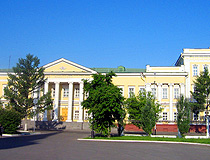
The Omsk Cadet Corps
Author: Stanislav Katsko
Omsk - Features
Omsk is located in the south of the West Siberian Plain at the confluence of the Om River into the Irtysh, about 150 km from the border of Russia with Kazakhstan. About 60% of all residents of Omsk Oblast live in Omsk. The City Day of Omsk is celebrated on the first Saturday of August.
The city’s coat of arms is very similar to the first coat of arms of Omsk approved by Empress Catherine II in 1785. It depicts a part of the brick fortifications, which symbolizes the reason for its foundation as a fortress and the center of the Siberian defensive line.
Omsk belongs to the temperate climatic zone with a continental climate of the forest-steppe of the West Siberian belt. It is distinguished by an abundance of sunlight. The average air temperature in January is minus 16.3 degrees Celsius, in July - plus 19.6 degrees Celsius. The highest wind speeds are observed in winter and spring, which is the reason for frequent snow and dust storms.
In the past, the ecological situation in Omsk was very unfavorable. Since 2011, the city’s environmental development rating has increased significantly. This was the result of large-scale modernization of many large industries (including the Omsk oil refinery). Today, road transport is the main source of air pollution in the city.
The level of pollution of the Omsk rivers - Irtysh and Om - remains consistently high. Swimming in them is prohibited. While industrial effluents are becoming more environmentally friendly, sewers are releasing waste products including diesel fuel and petroleum products into the rivers. Dust raised by dust storms is also a serious problem for the city as it contains a lot of harmful substances including lead.
The city’s industry is based on oil refining, petrochemistry, chemical industry, mechanical engineering (production of aerospace equipment, armored vehicles, agricultural equipment). Omsk is a major transport junction - the Trans-Siberian Railway runs through the city from west to east, and the navigable Irtysh River crosses it from south to north. Omsk Airport offers regular flights to Moscow, St. Petersburg, Novosibirsk, Tyumen, Surgut, Yekaterinburg, Krasnoyarsk, Salekhard, Kazan, Krasnodar, Sochi.
The unfinished subway of Omsk has become famous in Russia thanks to its only one fully built station. Its construction began back in 1992. However, due to funding problems, the completion of the first line was postponed numerous times. In 2019, it was finally decided to permanently stop construction. For local residents, because of the long wait for the completion of the construction, the Omsk metro symbolizes unrealizable hopes, they talk about it with irony.
In Omsk, there are practically no buildings higher than 50 meters, according to this parameter it is one of the lowest cities with a population of over one million. 130 architectural monuments are concentrated in the central part of the city, almost half of the total number.
Main Attractions of Omsk
Dormition Cathedral - the largest church in Omsk located in the very center of the city. The original church was built in 1891-1898. In 1935, it was completely destroyed. In 2005-2007, an exact copy of the building was restored in its original place. This is one of the most beautiful buildings in Omsk. At night, the building is illuminated and looks especially majestic. Tarskaya Street, 7.
Irtysh Embankment - the main walking street of Omsk with a picturesque view of the Irtysh River. Built in the middle of the 20th century, the embankment was reconstructed in the 2000s. You can walk along the alley on foot, ride rollerblades or a bike.
Merchant Batyushkin’s Mansion (1902). This architectural monument is located on the Irtysh Embankment. It is also known as the Kolchak’s House because Alexander Kolchak, the Supreme Ruler of Russia, lived in this building in 1919. One part of the building is occupied by the registry office of the Central District of Omsk. The Center for the Study of the History of the Russian Civil War is also open here. Irtyshskaya Naberezhnaya Street, 9.
Omsk State Museum of History and Local Lore - one of the oldest museums in Siberia and Russia founded in 1878. In total, this museum has over 200 thousand various objects of cultural, historical and artistic value. The museum is especially proud of such exhibits as the cast-iron figures of the Chinese lions Shi-Tzu, presented to the museum from China in 1895, as well as the skeleton of a woolly mammoth almost 3 meters high. Lenina Street, 23?.
Omsk Regional Museum of Fine Arts named after M.A. Vrubel - one of the largest museums of fine arts in Siberia. It has collections of foreign and Russian art from antiquity to the present day. In total, there are over 22 thousand works by painters, graphic artists and sculptors, as well as more than 1.5 thousand rare folios.
Walking through the exhibition halls, you can admire the canvases of Shishkin, Aivazovsky, Surikov, Repin, Serov, Vereshchagin. The exhibition of rare icons dating from the 17th-20th centuries is of constant interest among visitors, as well as a unique collection of jewelry made of precious metals found in the Scythian and Sarmatian burial mounds. Two buildings of the museum are located at Lenina Street 3 and 23.
In November 2019, a new exhibition was opened in a historical building at Muzeynaya Street, 4 - the exhibition of art of the 20th-21st centuries. The Hermitage-Siberia Center is located here too - the first representation of The State Hermitage Museum (the second-largest art museum in the world) beyond the Urals.
Chokana Valikhanova Street - a pedestrian street located in the historic part of Omsk. The street is decorated with abstract architectural forms, flower beds, wrought-iron lanterns. The walking area ends with an observation deck with a picturesque view of the Irtysh River.
Museum of Kondraty Belov. The museum of this landscape painter born in Omsk can be found in a picturesque wooden house, which is considered one of the most interesting architectural monuments of Omsk. The exposition tells about the life and work of Kondraty Belov, as well as about the history of the building itself.
In total, this museum has about 700 exhibits. The permanent exhibition also includes works by Kondraty Belov’s son Stanislav and paintings by some other local artists. In addition, temporary exhibitions of contemporary Omsk artists are regularly held here. Chokana Valikhanova Street, 10.
Plumber Stepanych Monument - an unusual sculpture located in the center of Omsk, which you can literally stumble upon while walking along Lenin Street between the houses #12 and #14. Leaning out of the hatch, the plumber is depicted as realistic and life-size as possible. It is among the most photographed monuments in Omsk. There is a similar sculpture in Bratislava, the capital of Slovakia.
Lyuba Monument. This sculpture, located on the opposite side of Lenin Street from the monument to the plumber Stepanych, is especially loved by Omsk residents and tourists, who love to be photographed against its background.
This beauty in a lace dress with a neckline and a crinoline sitting on an openwork bench and reading a novel had a real prototype - Lyubov (diminutively Lyuba or Lyubasha) Gasford, the wife of the Governor-General of Siberia, who lived in Omsk in the 19th century and died at a young age due to illness. One of the streets of Omsk and the park are named in her memory. She is a local symbol of femininity and beauty.
Omsk Fire Tower - a picturesque architectural monument built at the beginning of the 20th century. Inside the tower there are museum expositions dedicated to the local fire brigade and the history of tower construction. Internatsionalnaya Street, 41?.
Park of Culture and Rest named after the 30th anniversary of the Komsomol - a popular place for walks, recreation and entertainment of Omsk residents and tourists, which has retained “the spirit of the Soviet era” in its name. Today, on an area of 73 hectares, several zones have been organized, various types of recreation are presented. There are walking alleys, ponds, water activities, for example, riding on hydro-scooters.
The ice town is open in winter, the Return of the Dinosaurs exhibition - in summer. The “House Upside Down” exposition is also popular with tourists. This park is a place for mass festivities, city celebrations and events. Maslenitsa, Christmas, City Day, and other holidays are celebrated here. Maslennikova Street, 136.
Natural Park “Bird Harbor” - a specially protected area located on the path of bird migration in the central part of Omsk. During autumn flights, up to 3 thousand birds stop here for rest. It is a great place to enjoy nature, walk along the eco-trail, and observe the life of birds. The park is situated in the floodplain on the left bank of the Irtysh River next to the Victory Park on Yeniseyskaya Street.



